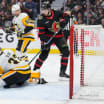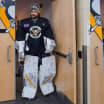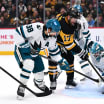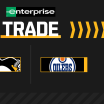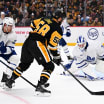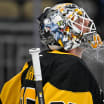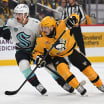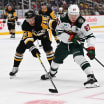During the Penguins' 6-5 overtime win over Boston on Jan. 7, Sidney Crosby carried the puck up the ice on a 2-on-1 rush with Daniel Sprong.
Crosby tried to thread a pass over, but the play was broken up by Bruins defenseman Matt Grzelcyk. When they returned to the bench, Crosby pulled out an iPad and talked through what had happened with Sprong.
iPads on bench a great tool for Pens
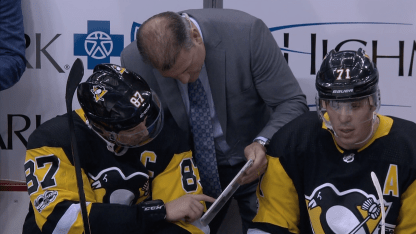
By
Michelle Crechiolo
Penguins Team Reporter
"Just on the 2-on-1, he wanted me to slow down a bit," Sprong said. "I asked him at what point he wants me to slow down and we read off the D, so it's good that we're talking a lot and I think that really helps. I was kind of behind him so I didn't have the chance to go all the way to the back, so that's when I've just got to pull up a little bit and make it easier for him."
Having a teaching moment like that, during a game, in real time, wasn't possible before the 2017 Stanley Cup playoffs, which is when the NHL made a deal with Apple to deliver video and data to the bench on a tablet. They decided to use a system called iBench, which is powered by a company called XOS Digital.
Many teams, including the Penguins, were already using XOS Digital's video platform called Thunder Hockey to capture in-game feeds for hockey operations use, so it made sense to use the same company to stream video on the iPads.
The buildings of all 16 playoff teams were outfitted, which was a process considering the iPads have to operate on the same WiFi as the fans in the arena. They situated the access points and bandwidth usage, and as teams got eliminated, they were able to narrow their focus. It worked so well that they decided to expand it to all 31 buildings this summer, which was a big undertaking, but a big success.

"A lot of people thought they were crazy to think they would start it at the playoffs last year, but it was a pretty good time to try it," said Brant Berglund, director of hockey products for XOS Digital. "It was something no one was dependent upon, it wasn't mission critical at that point. People could pick it up and use it or leave it alone for now until they were more comfortable. A lot of teams really jumped in, particularly the two teams that made it to the Final."
Obviously, the Penguins were one of those teams, and it was important to head coach Mike Sullivan that they embrace the new technology.
"Mike Sullivan said at a users' conference this summer something along the lines of, 'we knew it would give us a competitive advantage if we were good at it and a disadvantage if we weren't, so we decided to invest the time and figure out how it would work the best,'" Berglund said. "That's a credit to Mike, who's always been a progressive thinker."
Basically, this is how they work: Penguins video coach Andy Saucier captures the feed from the TV production truck on one of the computers in his office. The signal that he gets is then streamed out to those access points that are set up right behind the bench, and the iPads grab their feeds from there.
The iPads are set up like DVRs with controls at the bottom - for example, forward 10 seconds, forward five seconds, fast forward, slow motion. Whoever's using it can simply take their finger and just buffer through the timeline. It's not quite immediately available, but there's only about a 5-10 second delay.
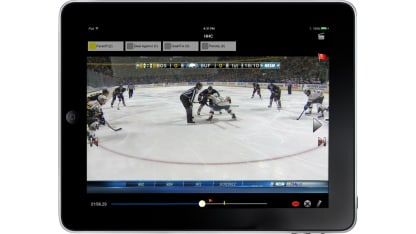
"It's definitely the simplicity of the iPad and the platform itself that really accentuates the quickness that these guys can use it," Berglund said. "We make the app and the NHL lays the groundwork for the connectivity and consistency of the signal, but the iPad is really the driving force behind all of it in terms of the ability to quickly navigate and use the Apple toolset. It's been a pretty good marriage between all three."
In addition, during a game, Saucier is tagging everything and making a bunch of clips. For example, when the Penguins score a goal, he presses a button and the play rolls back a certain number of seconds and forward a certain number of seconds. Since the iPads are tied into the program Saucier is using, that will be displayed on the tablet on the bench as a ticker mark in the timeline.
"It's easy when you're just watching from either up top or on the TVs, you can see the whole ice," Saucier said. "But for them, they're out there and it's a different view, so all of a sudden they can see it on video right after their shift is over. They can see what's available or they can see maybe where they have an opportunity to make a play or something like that. They really like it."
Last spring, it was Rick Tocchet who was the coach in charge of using the iPads. This year, it's Mark Recchi.
"They're great for the coaching staff because we can go back and look at teaching points with the guys," Recchi said. "Sometimes we get caught up talking to guys and something happens, or Sully might see something and he says, 'take a look at that and I'll take a look at it and I'll show the guys.' It's great, it really is. It really benefits teaching right on the bench, even if you miss something. It's great."
Though it's not just the coaching staff using them - more and more players have started taking the iPads into their own hands. That's just the generation they're from - they grew up using technology and they're incredibly comfortable with it, so it's been a perfect match in that regard.
"What was surprising was not necessarily the coaches grabbing them in a TV timeout, but it's the frequency you see them being grabbed when players come to the bench between whistles," Berglund remarked. "Someone has one in their hand and the great thing is to see it in player's hands. I'm not quite sure that was perceived. It was thought that players would be shown things by coaches but not for coaches to hand the reigns over to players.
"Our programmers and engineers, they may not watch a lot of games, but to see Sidney Crosby sitting by himself on the bench using it, you couldn't ask for a better thing to see."
Right now, the Penguins have three iPads on the bench, but Saucier joked that they're in such high demand they may need to re-evaluate that.
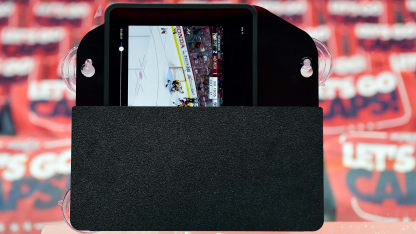
"I think when we first got them, it seemed like, why do we need three?" Saucier said. "But now Rex can't get his hands on one when he wants to see something and we have three players watching something, so we might need some more."
Recchi said that he needs two all the time for just the forwards, but it's not always easy to procure them.
"I go to look at something and I'm like, 'where the heck are my iPads?' And they're all looking at them," he laughed. "They all got it down pretty good now, too. They're looking right at the end of their shifts. It's a good tool for them because they can see. It might be even getting a shot on goal, what did they see on a replay, or something like that. So it's a huge benefit for everybody."
Especially for this Penguins team, a mix of elite superstars and young talent who are all constantly trying to get better and better each and every day.
"They watch a lot of video, really just on their own, it's not mandated at all," Saucier said. "But they all watch, they watch their shifts, they want to get better and having it immediately on the bench is huge. I think it's helped a lot for especially our guys, the types of personalities and types of learners we have."
That starts with Crosby, who's known for his incredible work ethic. As Sullivan has said, Crosby isn't as good as he is by accident.
"As long as I've been associated with this league I don't know that I've been around a player that has the same work ethic as Sid does as far as that insatiable appetite to try to just get better and be the best," Sullivan continued. "And I think that's why he's as good as he is."
Crosby thinks the game on another level, so he usually knows exactly when everything happened on the ice, and it doesn't take him long for him to find what he's looking for. At that point, he can look at the play and make his own adjustments, or have a visual tool to help explain to his teammates how to handle a certain situation.
"I think before, you'd have to wait till the end of the period," Crosby said. "You'd go over the power play, you might not adjust or you might not see something because you don't get a chance to really sit down and look at it for a period or so. So it's nice to not necessarily waste time, but that you can look at it quickly and maybe adjust a little bit more on the fly than you typically would."
But Crosby pointed out that it's important not to get overly reliant on the iPads.
"I think sometimes it can be too much, too," he said. "You don't want to get caught. The game's not static where you can just lay everything out the way you want to. But it's nice to be able to look at that stuff sometimes. I think just knowing that the game is pretty free-flowing, a lot of things happen out there, but it's a nice tool to have when you need it."







